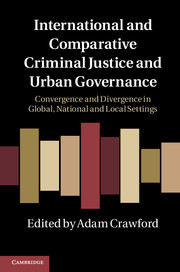 International and Comparative Criminal Justice and Urban Governance
International and Comparative Criminal Justice and Urban Governance from PART 2 - Comparative penal policies
Published online by Cambridge University Press: 05 June 2011
This chapter is about penal convergence which was then followed by divergence between two clusters of societies: England and New Zealand on the one hand, Finland, Norway and Sweden on the other. First it examines and explains initial post-1945 convergences between them in relation to prison rates and prison development. Secondly, it traces and explains the divergences that have since occurred between them. While these divergences begin around 1960, their pace has quickened, asFigure 10.1 illustrates in relation to prison rates (although Finland did not follow the same course as the other Scandinavian societies until the late 1960s). Indeed, the differences have become so marked that the Anglophone societies are now known for their penal excess (very high levels of imprisonment and deteriorating prison conditions), while the Scandinavian societies are known for their penal exceptionalism (very low levels of imprisonment and humane prison conditions).
What lies behind these moves from convergence to divergence? Any full account will involve a multi-factored explanatory framework, as recent research in comparative penology suggests. In this chapter, however, I want to give attention to the way in which the differing models of welfare state in these two clusters impacted on respective penal developments. The chapter thus draws on Esping-Andersen's (1990) typologies: the ‘liberal welfare state’ of the Anglophone countries that involved modest, means-tested benefits usually targeted at low-income dependents; and the ‘social democratic welfare state’ of the Scandinavian countries that involved universal provision and high rather than subsistence levels of benefit.
To save this book to your Kindle, first ensure [email protected] is added to your Approved Personal Document E-mail List under your Personal Document Settings on the Manage Your Content and Devices page of your Amazon account. Then enter the ‘name’ part of your Kindle email address below. Find out more about saving to your Kindle.
Note you can select to save to either the @free.kindle.com or @kindle.com variations. ‘@free.kindle.com’ emails are free but can only be saved to your device when it is connected to wi-fi. ‘@kindle.com’ emails can be delivered even when you are not connected to wi-fi, but note that service fees apply.
Find out more about the Kindle Personal Document Service.
To save content items to your account, please confirm that you agree to abide by our usage policies. If this is the first time you use this feature, you will be asked to authorise Cambridge Core to connect with your account. Find out more about saving content to Dropbox.
To save content items to your account, please confirm that you agree to abide by our usage policies. If this is the first time you use this feature, you will be asked to authorise Cambridge Core to connect with your account. Find out more about saving content to Google Drive.